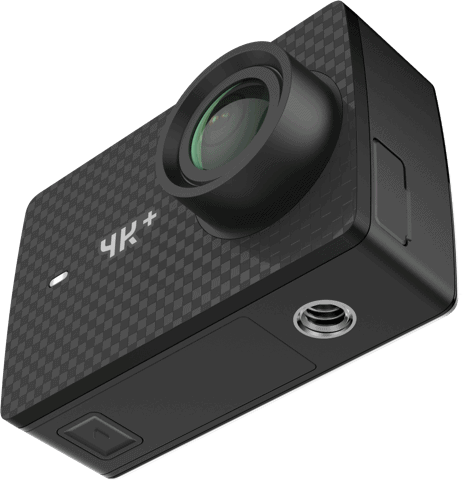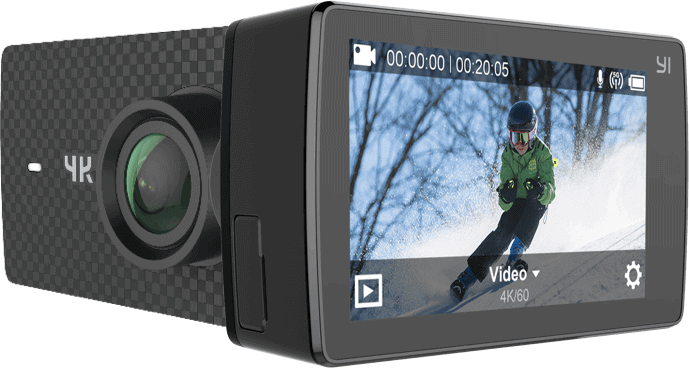One year ago, with the release of their Yi 4K+, Yi Technology stopped catching up to GoPro and became an innovator in the field of action cameras. The successor to the popular but flawed Yi 4K brought with a change that rivals couldn’t yet match: A frame rate of 60 FPS at a 4K resolution (commonly known as 4K60). It took GoPro half a year to match the specifications of the Yi 4K+. Sony and Garmin have yet to respond.
Higher frame rates have long been popular in action videography. So much so that many chose to sacrifice resolution for smoother looking footage. With the advances made this was no longer necessary and we’ve finally got a pocketable camera with support for 4K60.
Because of the quality control issues I (and many others) experienced with the Yi 4K, I waited for the early reviews to roll in before placing an order. For the past six months I’ve been using a Yi 4K+ for all kinds of shoots. This little camera has joined me on many bike tours and holidays. What made me stick with the Yi 4K+ will be the subject of this article. Before we start judging the quality, let’s have a look at the device itself!
Some things never change
The Yi 4K+ and the older Yi 4K have a few things in common, namely the sensor and design. The Sony IMX377 sensor is still at the heart of this camera. Having been on the market since April 2015 it might not be the newest sensor yet is still a capable bit of technology. After all, the same sensor also sits in the popular DJI Mavic Pro quadcopter. With all that said, I’d still like to see a worthy successor to the Yi 4K+ with an upgraded sensor making it more comparable to the current crop of smartphones.
On a more positive note, the design hasn’t changed either. The Yi 4K+ is compatible with all of the accessories that the Yi 4K was. In fact, Yi Technology has recently released the Yi Lite, which also has the same design. It’s safe to assume that this design will stick around.
The Yi 4K+ is, just as its predecessor was, equipped with WiFi, allowing users to control their camera using an iOS or Android app. The app hasn’t changed much since the release of the Yi 4K and offers the same great functionality. You’re able to control settings, view and download images and remotely trigger the camera.
Yi 4K+ build quality
The Yi 4K+ comes in a matte-black casing with a carbon fiber design on the front. Don’t be fooled, it’s still plastic. Good looking plastic, but nothing more. Currently there are no other colour options available. The plastic feels slightly soft and rubbery (comparable with a Nexus 5 and Nexus 7 if you’ve ever felt one of them). The change in materials used is a welcome one, as the plastic used on the Yi 4K was far to brittle. Mine started cracking after just a few uses. Considering it’s an action camera that really is unacceptable. Luckily, I’ve had no such issue with the Yi 4K+. It appears Yi Technology learned from their mistake and listened to the community on this issue.

With one issue disappearing, another one appears. Luckily not quite as bad as a cracked case, yet still rather annoying. There’s a little cover over the USB Type-C port which doesn’t quite fit. The port will randomly flap open when I’m out filming, which never happened with Yi 4K. Reading reports online, it appears that this is a widespread issue and not just something plaguing my unit.
The 2.2” screen on the back of my unit hasn’t been scratched in over 6 months of use. I’ve used it in the sea, on beaches and even in the desert but the screen has held up. Touch latency isn’t quite up there with current smartphones but it’s good enough. Once you’ve tried an action camera with a touchscreen, there’s no going back. Because all of the settings are made using the screen, there’s only a single button, which functions as power and shutter button.

Unfortunately the Yi 4K+ is still not waterproof without a housing. Waterproofing is something we’ve come to expect when buying smartphones and it’s a feature a high-end action camera should definitely have. The waterproof housing will restrict you from using the screen. Though the camera does have a in housing mode, it’s no comparison to being able to use the touchscreen.
USB Type-C
Special mention goes to the Yi 4K+ having a USB Type-C port and giving up on Micro-USB. As I mentioned in my previous Dell TB16 review, I want all of my gadgets to make the switch. The new port doesn’t just play nice with USB Type-C chargers. Added advantages are higher transfer speeds and the availability of accessories. Yi Technology has finally enabled the use of external microphones via USB Type-C! Though you’ll need an adapter made by Yi Technology as others won’t work.
Firmware
You can’t fault Yi Technology on their support of the Yi 4K+. There’ve been multiple firmware updates delivered over the air using the mobile app. Most updates have not just been bug fixes but have brought along new features, making the camera better as the months go by. I’ve highlighted a few of these in the list below:
1.4.12
- Optimized EIS, the view of picture is more wide and the footage is more stable.
- Optimized image effect, improved the saturation, the color in low-light is more rich, the image is no longer greenish in daylight and no longer yellowish in Tungsten.
1.4.8: Added composition guides
1.3.23
- Optimized the video sound in some scenarios, such as Bar, Concert
- Optimized the image quality under long exposure, decreases the noise
- Updated IQ parameters, reduce the green highlights
1.2.8: Added shutter speed choice for Photo, Timer and Time Lapse Photo Mode, supports 1/500s, 1/125s, 1/30s, 1/8s, 1/2s and 1s
1.1.7
- Added fixed ISO value when in video mode
- Added RAW image capture and voice control function
There is an active Yi Technology group on Facebook which is frequently visited by developers and other Yi Technology employees. In my experience the Facebook group is the quickest way to be heard. Now and again you’ll also find a beta firmware published in the group. For this review I’m using the latest firmware (1.4.12) and have recorded all the footage that has led to my conclusion.
Yi 4K+ video quality
Electronic Image Stabilisation (EIS)
I’ve mentioned it before and I’ll mention it again: Electronic Image Stabilisation (EIS) is still no compensation for Optical Image Stabilisation (OIS). Sony managed to implement OIS in their FDR-X3000R action camera but Yi Technology and GoPro are seemingly still struggling with this feature. EIS will attempt to smooth out footage by using data from the built-in gyroscope and accelerometer. By doing that, the image being recorded will be cropped, thus reducing the Field of View (FOV). With OIS the sensor actually moves inside of the camera. Footage shot with OIS will look a lot more natural compared to EIS. Another disadvantage of EIS is its use of processing power. Because it’s the processor doing the calculations, EIS is not available at 4K60. To achieve smooth footage at 4K60 you will either need a gimbal or apply stabilisation in post-production.
Flat vs. Yi Colour
The Yi 4K+ supports two different colour profiles: Yi Colour and Flat. The flat colour profile will record footage with low contrast and high dynamic range. As with RAW photos, the camera retains more information and doesn’t apply a huge amount of colour information. Shooting in the flat colour profile provides a solid base for colour grading in post-production. And that post-production is necessary. The flat colour profile will make your footage look muddy and won’t have much colours right out of the camera.
Let’s not forget about audio
Following the trend, the Yi 4K+ uses two microphones to capture audio. In order to reduce wind noise, one has been placed on the top of the camera (next to the button) and one is located on the side of the camera. The placement is an improvement on the Yi 4K, which did have two microphones, but both were placed in close proximity.
Yi 4K+ photo quality
If you’re anything like me, you’re not just using the action camera for video but also for photo. The Yi 4K+ shoots 12 MP in either the RAW or JPEG format. Alongside that there are multiple different modes available for every situation.
RAW vs. JPEG
While the Yi 4K+ does support RAW capture in the Digital Negative (DNG) format, it’s not something I’d recommend to the crowd it’s aimed at. RAW capture is slow. Very slow. There are many advantages of shooting RAW, the main being able to post-process with more flexibility. RAW files contain all of the sensor information, whereas JPEG files are compressed. A camera will do a lot more than just compress the image when shooting JPEGs. The data from the sensor will have little saturation and sharpness which the camera adds, among other things, when saving JPEGs. When shooting RAW that part will have to be done by the photographer. RAW photos don’t look good straight out of the camera and will have to be edited in a programme like Adobe Lightroom or Snapseed.
Talk to me: voice control on the Yi 4K+
The Yi 4K+ wasn’t launched with voice control but the feature has since been added with a firmware update.
Connection problems between the YI 4K+ and Android phones
The Yi 4K+ (and the previous Yi 4K) have always had problems connecting to my Google Pixel. Going by the posts made in forums, I’m not the only Android user experiencing this problem. There is a simple solution: Turn off mobile data. Don’t ask me why this hasn’t been fixed yet, but as soon as you turn off that option my Pixel will connect in seconds.
Summary
Pros
- Affordable 4K60 in a small package
- Previous quality control issues have been resolved
Cons
- No Optical Image Stabilisation
- An aging sensor just can’t keep up with current smartphone offerings.
The future
I haven’t read a single rumour on a possible successor to the Yi 4K+ yet and it’s still a very capable high-end action camera. In the unlikely event that anybody at Yi Technology is reading this, here’s my list of wishes for a possible Yi 4K+ successor (would that be the Yi 5K? Or the Yi 4K++?):
- Add Optical Image Stabilisation (OIS) for all resolutions and framerates and I’m sold. I will be buying any future Yi camera with OIS.
- The Google Pixel and Pixel 2 are known to have great, possibly the best, smartphone-cameras. This is all because of HDR+. Were a future Yi camera able to create photos using an automatic HDR mode it would be a major win. GoPro has recently managed to enable HDR for photos and video, here’s hoping Yi Technology takes note.
- Starting with the GoPro Hero 5, Yi Technology’s main rival have been able to waterproof their cameras without a casing. It’s time for Yi cameras to catch up!
- Start using the H.265 codec, also known as HEVC, instead of H.264. Smaller file sizes and fewer SD cards is never a bad thing.